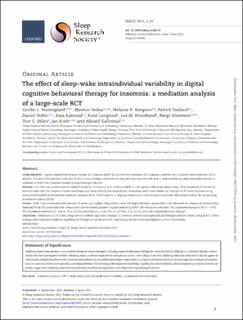| dc.contributor.author | Vestergaard, Cecilie Lund | |
| dc.contributor.author | Vedaa, Øystein | |
| dc.contributor.author | Simpson, Melanie Rae | |
| dc.contributor.author | Faaland, Patrick | |
| dc.contributor.author | Vethe, Daniel | |
| dc.contributor.author | Kjørstad, Kaia | |
| dc.contributor.author | Langsrud, Knut | |
| dc.contributor.author | Ritterband, Lee M | |
| dc.contributor.author | Sivertsen, Børge | |
| dc.contributor.author | Stiles, Tore C | |
| dc.contributor.author | Scott, Jan | |
| dc.contributor.author | Kallestad, Håvard | |
| dc.date.accessioned | 2022-03-01T09:22:16Z | |
| dc.date.available | 2022-03-01T09:22:16Z | |
| dc.date.created | 2021-09-20T13:14:41Z | |
| dc.date.issued | 2021 | |
| dc.identifier.citation | Sleep. 2021, 44 (10), 1-10. | en_US |
| dc.identifier.issn | 0161-8105 | |
| dc.identifier.uri | https://hdl.handle.net/11250/2981971 | |
| dc.description.abstract | Study Objectives Digital cognitive behavioral therapy for insomnia (dCBT-I) is an effective treatment for insomnia. However, less is known about mediators of its benefits. The aim of the present study was to test if intraindividual variability in sleep (IIV) was reduced with dCBT-I, and whether any identified reduction was a mediator of dCBT-I on insomnia severity and psychological distress. Methods In a two-arm randomized controlled trial (RCT), 1720 adults with insomnia (dCBT-I = 867; patient education about sleep = 853) completed the Insomnia Severity Index (ISI), the Hospital Anxiety and Depression Scale (HADS) and sleep diaries, at baseline and 9-week follow-up. Changes in IIV were analyzed using linear mixed modeling followed by mediation analyses of ISI, HADS, and IIV in singular sleep metrics and composite measures (behavioral indices (BI-Z) and sleep disturbance indices (SI-Z)). Results dCBT-I was associated with reduced IIV across all singular sleep metrics, with the largest between-group effect sizes observed for sleep onset latency (SOL). Reduced IIV for SOL and wake after sleep onset had the overall greatest singular mediating effect. For composite measures, SI-Z mediated change in ISI (b = −0.74; 95% confidence interval (CI) −1.04 to −0.52; 13.3%) and HADS (b = −0.40; 95% CI −0.73 to −0.18; 29.2%), while BI-Z mediated minor changes. Conclusion Reductions in IIV in key sleep metrics mediate significant changes in insomnia severity and especially psychological distress when using dCBT-I. These findings offer important evidence regarding the therapeutic action of dCBT-I and may guide the future development of this intervention. Clinical trials Name: Overcoming Insomnia: Impact on Sleep, Health and Work of Online CBT-I. Registration number: NCT02558647 | en_US |
| dc.language.iso | eng | en_US |
| dc.publisher | Oxford University Press | en_US |
| dc.rights | Navngivelse 4.0 Internasjonal | * |
| dc.rights.uri | http://creativecommons.org/licenses/by/4.0/deed.no | * |
| dc.title | The effect of sleep-wake intraindividual variability in digital cognitive behavioral therapy for insomnia: a mediation analysis of a large-scale RCT | en_US |
| dc.type | Peer reviewed | en_US |
| dc.type | Journal article | en_US |
| dc.description.version | publishedVersion | en_US |
| dc.source.pagenumber | 1-10 | en_US |
| dc.source.volume | 44 | en_US |
| dc.source.journal | Sleep | en_US |
| dc.source.issue | 10 | en_US |
| dc.identifier.doi | 10.1093/sleep/zsab118 | |
| dc.identifier.cristin | 1936020 | |
| dc.relation.project | Norges forskningsråd: 239985 | en_US |
| cristin.ispublished | true | |
| cristin.fulltext | original | |
| cristin.qualitycode | 1 | |

